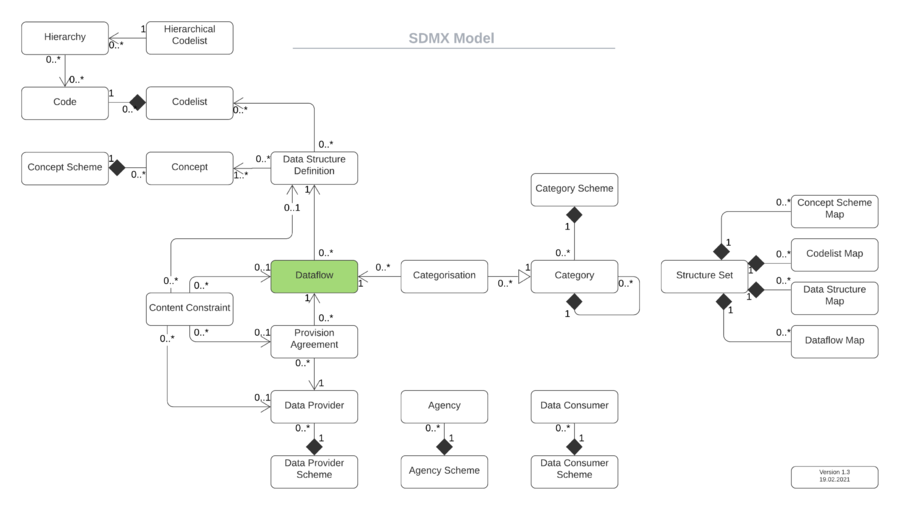Difference between revisions of "Dataflow V10"
| Line 1: | Line 1: | ||
[[Category:SDMX Structures]] | [[Category:SDMX Structures]] | ||
=Overview= | =Overview= | ||
| − | A Dataflow represents a Data Set. While a Data Structure Definition defines Dimensions, Attributes, Measures and associated representation that comprise the valid structure of data and related metadata of Data Sets of a particular class, a Dataflow is a specific instance. This decoupling of Data Structure Definitions from Dataflows makes them reusable. A Data Structure Definition for health data may be used by many different organisations and countries, each using it to create their own Dataflows. The European Central Bank (ECB) have a Balance Sheet Items DSD which is referenced by three Dataflows: Balance Sheet Items; Balance Sheet Items Statistics (tables 2 to 5 of the Blue Book), Key euro area indicators (BSI). | + | A Dataflow represents a Data Set. |
| + | |||
| + | While a Data Structure Definition defines Dimensions, Attributes, Measures and associated representation that comprise the valid structure of data and related metadata of Data Sets of a particular class, a Dataflow is a specific Data Set instance. | ||
| + | |||
| + | This decoupling of Data Structure Definitions from Dataflows makes them reusable. A Data Structure Definition for health data may be used by many different organisations and countries, each using it to create their own Dataflows. The European Central Bank (ECB) have a Balance Sheet Items DSD which is referenced by three Dataflows: Balance Sheet Items; Balance Sheet Items Statistics (tables 2 to 5 of the Blue Book), Key euro area indicators (BSI). | ||
Data is disseminated against a Dataflow and must conform to the template defined by the DSD that the Dataflow references. | Data is disseminated against a Dataflow and must conform to the template defined by the DSD that the Dataflow references. | ||
Revision as of 07:50, 18 March 2021
Contents
Overview
A Dataflow represents a Data Set.
While a Data Structure Definition defines Dimensions, Attributes, Measures and associated representation that comprise the valid structure of data and related metadata of Data Sets of a particular class, a Dataflow is a specific Data Set instance.
This decoupling of Data Structure Definitions from Dataflows makes them reusable. A Data Structure Definition for health data may be used by many different organisations and countries, each using it to create their own Dataflows. The European Central Bank (ECB) have a Balance Sheet Items DSD which is referenced by three Dataflows: Balance Sheet Items; Balance Sheet Items Statistics (tables 2 to 5 of the Blue Book), Key euro area indicators (BSI).
Data is disseminated against a Dataflow and must conform to the template defined by the DSD that the Dataflow references.
Data is also reported (indirectly) against a Dataflow, so it is possible to impose different restrictions on difference Dataflows using Constraints.
Structure Properties
| Structure Type | Standard SDMX Structural Metadata Artefact |
|---|---|
| Maintainable | Yes |
| Identifiable | Yes |
| Item Scheme | No |
| SDMX Information Model Versions | 2.0, 2.1 |
| URN - datastructure.Dataflow namespace | urn:sdmx:org.sdmx.infomodel.datastructure.Dataflow. |
Context within the SDMX 2.1 Information Model
The schematic illustrates the core artifacts of the SDMX 2.1 Information Model, and how Dataflows fit in. A Dataflow requires a Data Structure, please refer to this article for more information on Data Structures.
Usage
In conjunction with a Provision Agreement, data can be loaded and validated against the concepts and rules and restrictions as defined in its Data Structure. A Dataflow may also have additional restrictions applied by virtue of any Content Constraints.
Conventions
Dataflow IDs IDs are conventionally uppercase using underscores '_' as separators if required. Examples:
| Agency | Concept Scheme ID | Description | SDMX-ML |
|---|---|---|---|
| ESTAT | NAREG_T1200_A | NA Regional Statistics | SDMX-ML |
| IAEG-SDGs | DF_SDG_GLC | SDG Country Global Dataflow | SDMX-ML |
You can seem more examples and information on Identities in this article.
